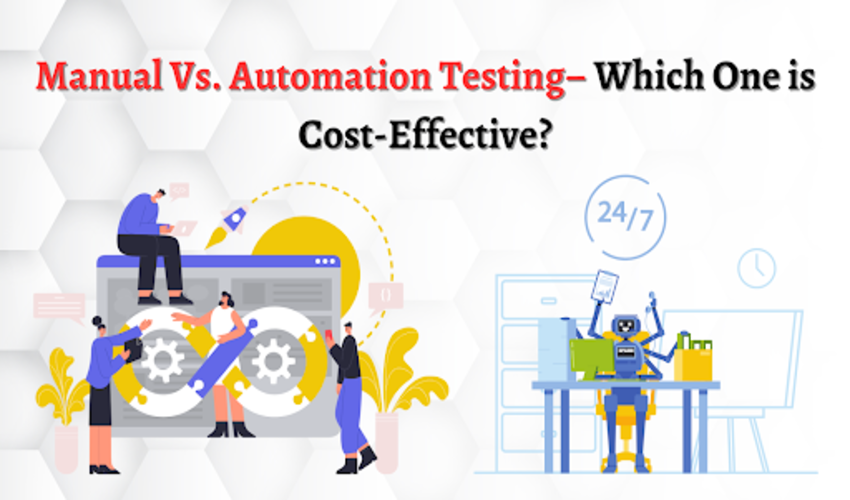
The IT market is ever-growing, making it challenging for businesses to stay upfront in this competition. People demand software with better speed and seamless operations. Delivering high-performing software can enable businesses to achieve objectives like enhanced customer satisfaction, customer loyalty, product or service accessibility, etc.
Therefore, stringent software testing services are necessary to ensure there are no errors or issues in the code. Moreover, it also helps to achieve optimal performance levels post-rollout. Here comes the data-driven manual and automation testing strategies into play.
Manual testing and automation testing serve different purposes in evaluating software functionality. So, automation testing vs. manual testing, which one is more suitable for your project? Cost is a primary factor influencing your choice of testing methodology. A comparison between manual and automation testing estimation can help you decide which technique is best suited for your software.
What is the Difference Between Manual Testing Vs. Automation Testing?
Software testing is a vast landscape. It includes white-box testing, black-box testing, performance testing, system testing, load testing, etc. Some synchronize better with manual testing, while some function efficiently with automation testing. Thus, it is necessary to understand the difference between the two to identify which testing methodology is compatible with your software.
Manual Testing:
In the traditional manual testing method, QA engineers identify errors and defects in the software manually. They follow a defined test plan comprised of various test cases to figure out the defects in the features of a given software, application, or program.
An experienced QA team executes the test cases and generates test reports without using automation testing tools. They analyze the user behavior to determine how they will perceive the software feature and whether it delivers a different or erroneous behavior than what is intended.
QA testers submit the errors or inconsistencies identified in the software and report them to the developers to get them fixed. All of this process is often complicated and executed under pressure to push the code into production immediately. Therefore, manual testing can take more time, resources, and effort.
Automation Testing:
Automation testing is done utilizing automation tools and frameworks. Testing software enables an automation tester to write and executes test scripts and test cases to discover errors or bugs in the code.
Automation testing reduces the number of test cases and simplifies the complex testing process. However, it cannot completely replace manual testing as certain issues and software behavior errors must be addressed manually.
In automation testing, it is essential to choose a suitable automation testing framework as per
your project requirements and budget. This can significantly affect the quality of your automation testing services and, in turn, increase costs.
When you have to perform repetitive testing tasks or have less number of dedicated testers, automation testing can be a suitable option for your project. However, if you need human observation and cognitive abilities, manual testing is best to ensure a high-end user experience.
Cost-Driving Factors of Manual and Automation Testing
Since manual testing and automation testing are significantly distinct from each other, different parameters influence the software testing cost. Finding the right balance between automation and manual testing is essential for highly efficient and cost-effective testing.
Here are the factors based on which you can select a cost-effective testing method.
- Initial Investment
In automation testing, initial investment is significantly higher than in manual testing. This cost involves automation testers’ charges and the price of automation tools, which can be quite costly. At the same time, manual testing estimation includes the cost of setting up the team and hiring experienced manual testers.
- Project Complexity
The project complexity also influences the cost of testing. For instance, manual testing can be a cost-effective option in a short-term project. However, this can cost you higher than expected in the long run. Therefore, it is necessary to deduce your project requirements to determine if you need manual or automated testing.
- The Subject of Investment
The cost of automation testing includes charges for testing tools and frameworks and automation QA engineers. On the other hand, the manual testing cost goes into hiring an in-house team or outsourcing software testing services as per your requirements.
- Test Volume for Cost-Efficiency
Since automation testing is done in case of repetition of tasks, this can be a cost-effective testing process. This involves paid and open-source tools to execute the same test cases. In comparison, manual testing includes different test cases and stringent processes, which can increase the price in the long run or when the testing process is re-run.
- Testing Efficiency
Using automation tools allows testers to execute more test cases in a short span of time. Moreover, these test cases are reusable and sustainable, making the testing process more cost-effective. On the other hand, manual testing takes more time and effort to execute test cases, making it more time-consuming.
Manual or Automation Testing: Which One is Better?
The parameters like test efficiency, test coverage, and testing types influence the cost of software testing. Manual and automation testing are required for your software to run smoothly. Therefore, it is essential to determine which parts of the testing process will be automated and which parts will be conducted manually. This will ensure faster deployment of bug-free software, which is also cost-effective.
Author Bio
Daisy Brown is a Sr. Quality Analyst at SparxIT, specializing in providing software testing services. She has been in this industry for more than 6 years. In her free time, she loves reading and writing about intelligent technologies and their use cases in testing.
